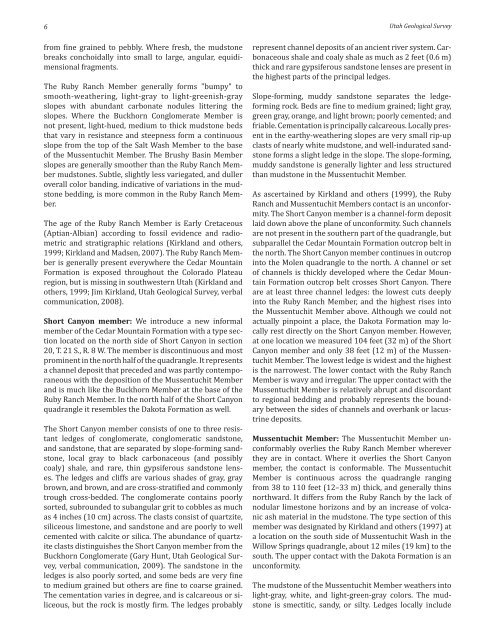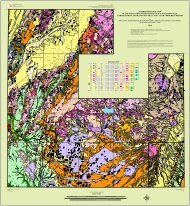download pdf - Utah Geological Survey - Utah.gov
download pdf - Utah Geological Survey - Utah.gov
download pdf - Utah Geological Survey - Utah.gov
You also want an ePaper? Increase the reach of your titles
YUMPU automatically turns print PDFs into web optimized ePapers that Google loves.
6<br />
from fine grained to pebbly. Where fresh, the mudstone<br />
breaks conchoidally into small to large, angular, equidimensional<br />
fragments.<br />
The Ruby Ranch Member generally forms "bumpy" to<br />
smooth-weathering, light-gray to light-greenish-gray<br />
slopes with abundant carbonate nodules littering the<br />
slopes. Where the Buckhorn Conglomerate Member is<br />
not present, light-hued, medium to thick mudstone beds<br />
that vary in resistance and steepness form a continuous<br />
slope from the top of the Salt Wash Member to the base<br />
of the Mussentuchit Member. The Brushy Basin Member<br />
slopes are generally smoother than the Ruby Ranch Member<br />
mudstones. Subtle, slightly less variegated, and duller<br />
overall color banding, indicative of variations in the mudstone<br />
bedding, is more common in the Ruby Ranch Member.<br />
The age of the Ruby Ranch Member is Early Cretaceous<br />
(Aptian-Albian) according to fossil evidence and radiometric<br />
and stratigraphic relations (Kirkland and others,<br />
1999; Kirkland and Madsen, 2007). The Ruby Ranch Member<br />
is generally present everywhere the Cedar Mountain<br />
Formation is exposed throughout the Colorado Plateau<br />
region, but is missing in southwestern <strong>Utah</strong> (Kirkland and<br />
others, 1999; Jim Kirkland, <strong>Utah</strong> <strong>Geological</strong> <strong>Survey</strong>, verbal<br />
communication, 2008).<br />
Short Canyon member<br />
Short Canyon member: We introduce a new informal<br />
member of the Cedar Mountain Formation with a type section<br />
located on the north side of Short Canyon in section<br />
20, T. 21 S., R. 8 W. The member is discontinuous and most<br />
prominent in the north half of the quadrangle. It represents<br />
a channel deposit that preceded and was partly contemporaneous<br />
with the deposition of the Mussentuchit Member<br />
and is much like the Buckhorn Member at the base of the<br />
Ruby Ranch Member. In the north half of the Short Canyon<br />
quadrangle it resembles the Dakota Formation as well.<br />
The Short Canyon member consists of one to three resistant<br />
ledges of conglomerate, conglomeratic sandstone,<br />
and sandstone, that are separated by slope-forming sandstone,<br />
local gray to black carbonaceous (and possibly<br />
coaly) shale, and rare, thin gypsiferous sandstone lenses.<br />
The ledges and cliffs are various shades of gray, gray<br />
brown, and brown, and are cross-stratified and commonly<br />
trough cross-bedded. The conglomerate contains poorly<br />
sorted, subrounded to subangular grit to cobbles as much<br />
as 4 inches (10 cm) across. The clasts consist of quartzite,<br />
siliceous limestone, and sandstone and are poorly to well<br />
cemented with calcite or silica. The abundance of quartzite<br />
clasts distinguishes the Short Canyon member from the<br />
Buckhorn Conglomerate (Gary Hunt, <strong>Utah</strong> <strong>Geological</strong> <strong>Survey</strong>,<br />
verbal communication, 2009). The sandstone in the<br />
ledges is also poorly sorted, and some beds are very fine<br />
to medium grained but others are fine to coarse grained.<br />
The cementation varies in degree, and is calcareous or siliceous,<br />
but the rock is mostly firm. The ledges probably<br />
<strong>Utah</strong> <strong>Geological</strong> <strong>Survey</strong><br />
represent channel deposits of an ancient river system. Carbonaceous<br />
shale and coaly shale as much as 2 feet (0.6 m)<br />
thick and rare gypsiferous sandstone lenses are present in<br />
the highest parts of the principal ledges.<br />
Slope-forming, muddy sandstone separates the ledgeforming<br />
rock. Beds are fine to medium grained; light gray,<br />
green gray, orange, and light brown; poorly cemented; and<br />
friable. Cementation is principally calcareous. Locally present<br />
in the earthy-weathering slopes are very small rip-up<br />
clasts of nearly white mudstone, and well-indurated sandstone<br />
forms a slight ledge in the slope. The slope-forming,<br />
muddy sandstone is generally lighter and less structured<br />
than mudstone in the Mussentuchit Member.<br />
As ascertained by Kirkland and others (1999), the Ruby<br />
Ranch and Mussentuchit Members contact is an unconformity.<br />
The Short Canyon member is a channel-form deposit<br />
laid down above the plane of unconformity. Such channels<br />
are not present in the southern part of the quadrangle, but<br />
subparallel the Cedar Mountain Formation outcrop belt in<br />
the north. The Short Canyon member continues in outcrop<br />
into the Molen quadrangle to the north. A channel or set<br />
of channels is thickly developed where the Cedar Mountain<br />
Formation outcrop belt crosses Short Canyon. There<br />
are at least three channel ledges: the lowest cuts deeply<br />
into the Ruby Ranch Member, and the highest rises into<br />
the Mussentuchit Member above. Although we could not<br />
actually pinpoint a place, the Dakota Formation may locally<br />
rest directly on the Short Canyon member. However,<br />
at one location we measured 104 feet (32 m) of the Short<br />
Canyon member and only 38 feet (12 m) of the Mussentuchit<br />
Member. The lowest ledge is widest and the highest<br />
is the narrowest. The lower contact with the Ruby Ranch<br />
Member is wavy and irregular. The upper contact with the<br />
Mussentuchit Member is relatively abrupt and discordant<br />
to regional bedding and probably represents the boundary<br />
between the sides of channels and overbank or lacustrine<br />
deposits.<br />
Mussentuchit Member<br />
Mussentuchit Member: The Mussentuchit Member unconformably<br />
overlies the Ruby Ranch Member wherever<br />
they are in contact. Where it overlies the Short Canyon<br />
member, the contact is conformable. The Mussentuchit<br />
Member is continuous across the quadrangle ranging<br />
from 38 to 110 feet (12–33 m) thick, and generally thins<br />
northward. It differs from the Ruby Ranch by the lack of<br />
nodular limestone horizons and by an increase of volcanic<br />
ash material in the mudstone. The type section of this<br />
member was designated by Kirkland and others (1997) at<br />
a location on the south side of Mussentuchit Wash in the<br />
Willow Springs quadrangle, about 12 miles (19 km) to the<br />
south. The upper contact with the Dakota Formation is an<br />
unconformity.<br />
The mudstone of the Mussentuchit Member weathers into<br />
light-gray, white, and light-green-gray colors. The mudstone<br />
is smectitic, sandy, or silty. Ledges locally include

















